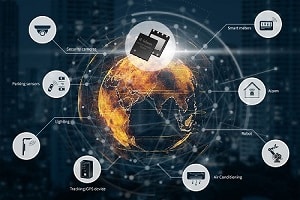- 5G cellular network is growing fast, covering a variety of applications
- The new OPTIGA Connect eSIM solution enables scalar cellular connectivity for IoT devices
 Cellular connectivity allows easy deployment and management of IoT devices by businesses due to its progressive infrastructure. To enable even better connectivity, a new eSIM turnkey solution called the OPTIGA Connect eSIM for cellular-connected IoT devices has been launched by Infineon. It’s small size aims to provide flexibility to device makers and manufacturers.
Cellular connectivity allows easy deployment and management of IoT devices by businesses due to its progressive infrastructure. To enable even better connectivity, a new eSIM turnkey solution called the OPTIGA Connect eSIM for cellular-connected IoT devices has been launched by Infineon. It’s small size aims to provide flexibility to device makers and manufacturers.
Importance of cellular connectivity
5G into the cellular connectivity infrastructure is regarded as a huge step forward in terms of security. It enables 100 times faster data transmission and 1000 times greater data capacity coupled with heavy data encryption and mutual authentication of devices and networks at the same time.
“With the progressive rise of IoT devices and the pervasiveness of cloud-based platforms and 5G deployment, cellular IoT connectivity will become a leading technology within the next few years,” says Lars Wemme, head of IoT Security at Infineon’s Digital Security Solutions division.
Compatibility with cellular technologies
The solution enables easy deployment and management of cellular-enabled IoT devices at scale.
It is present in two forms: the OPTIGA Connect Consumer and the OPTIGA Connect IoT. Launched in March this year, the OPTIGA Connect Consumer allows consumer devices to connect to mobile network operators. It is 5G ready and provides security according to GSMA requirements.
The newest member in the OPTIGA Connect solution, the OPTIGA Connect IoT is based on leading-edge security hardware and comes pre-loaded with worldwide bootstrap connectivity. This assists in simplifying supply chain connectivity after field deployment. The product meets GSMA requirements of remote SIM provisioning and provides robust industrial quality with an operating temperature range of -40 degrees Celsius to +105 degrees Celsius.
Regarding its compatibility with other cellular technologies such as LTE, CAT-M and NB-IoT, Christian Schneckenburger, technical marketing manager at Infineon said, “The product is 5G enabled and thus is the latest technology. It is compatible with 2G, 3G.4G as well as M2M options such as CAT-M or NB-IoT.”
About the kinds of GSM or cellular modems working with OPTIGA Connect and prerequisites required, he added that “The OPTIGA Connect is more or less transparent to the cellular modem. This means that a regular SIM can be replaced with the OPTIGA Connect IoT and it will work in the same way.”
A brief overview of the past
As reported earlier in March this year, the OPTIGA Connect eSIM for mobile consumer devices was launched.
According to the global tech market advisory firm ABI Research, global shipments of eSIM enabled smartphones have been expected to propel to over 225 million in 2020. Based on a continuation of eSIM support from leading handset manufacturers and eSIM expansion into other device ranges, ABI has expected a minimum of 500 million eSIM capable smartphones to be shipped globally in 2024.
“As the eSIM technology will be adopted firstly by big OEMs, our marketing activities will concentrate on major accounts at the beginning. In the second wave we might consider enabling distribution customers,” said Lars Wemme, head of IoT security at Infineon. “Our target audience (customers) are all OEMs and ODMs for wearable consumer devices (Mobile Phones, Wearables, Tablets, Laptops),” he said.
Through this launch, the company also reinstated its commitment to continue the supply of high-quality security hardware for SIM solutions, as it had been doing for the past twenty years. “We are convinced that the demand for embedded SIM will increase significantly in the long run. We are committed to continuously expand our offering with easy to integrate solutions that combine our high-quality hardware with software and additional services. So there is definitely more to come soon,” said Lars Wemme.
This paved the way for offering further integrated eSIM solutions, particularly with regard to cellular IoT connectivity.
Future market trends
According to a report by the networking and telecommunication provider Ericsson, 70 per cent of wide-area IoT devices will be using cellular technology in 2022 for connectivity.
Consumer market consists of three sub-segments: central connectivity hub (smartphones), connectivity extension (wearables) and processing power extension (computers/laptops). Concerning the growth of consumer eSIM-enabled devices over a five year period (2019 – 2024), smartphones will continue to have a larger share of the market at about 31 per cent followed by wearables and laptops.
For the IoT/M2M market, among the standing-out applications such as safety and autonomy, energy management, and track and trace, automotive has the largest share among eSIM enabled devices. Outside of this, energy management and asset tracking come second with a per year growth (from 2019 – 2024) of 18 per cent.
About the percentage of eSIM-based IoT devices versus all the other IoT devices, Lars Wemme said,” By 2022, 70 per cent of wide-area connectivity is expected to be a cellular-based implementation of eSIM solutions, which will accelerate the growing share.”
Widescale eSIM adoption a reality?
It is anticipated that eSIM will gradually replace traditional SIM cards in the future. Over-the-air SIM provisioning and mobile network operator (MNO) swapping gives consumers the benefit of flexible mobile network connectivity.
With that said, could traditional SIM be phased out of new devices? “As of today, a transition is happening and it’s difficult to predict when this transition phase will get over,” said Lars Wemme, head of IoT security at Infineon. He added “In the IoT device market, we can see more and more adoption of eSIM. But it will still take more years to see such kind of disappearance from the market.”
The news article was updated on 11th May 2020.




